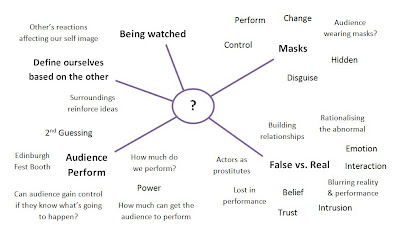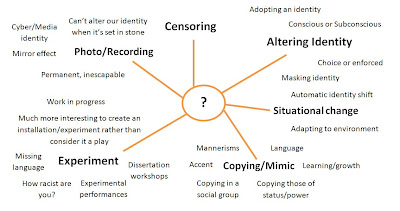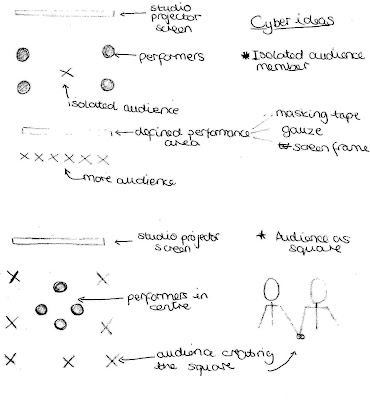Language
- Pretty happy with it
- Need to read through with everyone when J & J have had a chance to write the speeches.
Date
- Ben as the date participant
- No script though, more
improvisation

- Inspired by
Internal but not about just getting private secrets out of the audience member, about how humans interact, how we present, emit our identity to others, how our interactions with others create our identity.
- These are some articles Ben found that make an interesting observations at human interactions and what they say about us.
 Meet New People Without Being Creepy
Meet New People Without Being CreepyEverybody knows that first impressions count. And if the first impression you're giving is on the creepy side, you're probably tired of being misunderstood. This article will go over what makes someone seem creepy, and how you can stop giving off that creepy vibe.
For a start, its fascinating that even such an article exists! Not only is 'being creepy' shown as being such an issue that an article is needed, giving a glimpse into the paranoid problem society we live in, but that the way the writer has analysed and picked out the key techniques to 'solve' these 'vibes'.
1. Understand the stereotype of a creep
2. Commit to changing your behaviour
3. Become a good conversationalist
4. Let go of any neediness you might have
5. Respect boundaries
6. Pay attention to body language
The article goes into great detail about each of these aspects and while the advice given does some what ring a strangely precise bell, it does also seem to greatly simplify every aspect of human interaction. Is the way humans interact this fundamentally simple or is this way of thinking, trying to find a fast track way to connecting with others, damaging our ability to communicate with each other? Do or should we really be able to be put into a box so easily? Luckily, the article is kind enough to publish its own warning for its advice:
There are some people who will label anything different as weird and creepy. None of these steps will work with them because they're too shallow to appreciate individuality of any kind.
Remember - someone you perceive as 'creepy' could really be on the autism spectrum. Individuals on the autism spectrum usually do not have very good eye contact, talk constantly about their favourite subjects, are unsure about space. Try to accept someone who is 'creepy' because in their world they are one heck of a person.
 Have a Great Conversation
Have a Great Conversation
Thank goodness this next article exists too or there might be many out there who might never had been able to have a 'great' conversation with another.
The art of conversation takes practice, and is not as hard as you might think. With some patience and these steps, and you can learn to relax and enjoy a great conversation.
The first guideline is a bit problematic to say the least though,
Find out about the person you'll be talking to before you actually talk to them, if you can. If it's someone who you work with, or go to school with, look at their department website and see if they have any projects in the works. (Do not, however, dig any deeper than these suggestions. Coming into a conversation equipped with personal information about that person comes off as creepy. That means researching a person on social networks before talking to them for the first time is not okay!)
Luckily, this article also has its own warning section too.
Choose carefully when asking personal questions. You do not want to venture into overly personal issues. Even if the other person might be willing to talk about it, you may end up learning things that you really do not want to know. You certainly do not want the other person to think afterwards that you coerced them into revealing personal information.
Beware of topics that can be inflammatory - such as religion and politics - and don't venture into them unless you know the person has roughly the same convictions as you, or the circumstances otherwise allow for pleasant discussion. Again, it's fine to disagree and can be nice to talk about differences, but it can also be a quick step toward an argument.
Try not to ever cut the person off mid-sentence, or when they naturally pause between sentences (or when trying to remember a detail). It seems disrespectful and it makes it seem like you think that what you have to say is more important than what others have to say. Let the person finish their thoughts and then continue on with thoughts of your own.
Cyber
- Ideas need more developing
- Using the projector screen as the technological focus and then the actual activity more about the body
- Quite like to use this square for the chance of something more performative
- Losing action, inaction, all done from a computer screen, ritual
- Creating a cyber identity, reduction of body, name and profile
- Body reduced to a tool, mind & body never been as separated as now
- Body parts, disembodied
- The voice being
severed from the mind
- Want to show the
importance of the body to identity, body language
- Polaroid, human interface
- Identity of the
face - individual, recognition, social e.g. gender, age, expression, emotion, gaze
- Each body has an
interaction
- No eyes, no mouth, no hands, no ears... but steer away from the don't see, don't hear, don't speak campaign that has become a cliché.
- No speech, no face/external manifestation of self, no expression/emotion
- One face can
represent so much, and another so much completely different
-
Expression, security, sensuality, machinery
- Body as just a
tool, an instrument, vacant, marionette, machine
-
Hard to be yourself when you're
physically exposed, social graces, system of manners
- Voice, expression, masks, emotion, same person, mask of the screen,
what is being concealed online
- Smell, sound, senses,
lost, absent, touch
- Safety, can be very
real or very
fake over the Internet, yet we can't tell the difference.
Safety to conceal oneself but dangers that others can also. Can't tell if we're being told lies
- Takes away
social awkwardness, takes away the silences
- Formulaic
- Who has the
power? The speaker or the auditor? How does this differ from the norm?
Identity of the Face
When we were discussing the bodily identity and the exploration of how this is or isn't lost through cyberspace, one particularly interesting aspect of body identity was that of the face. Our facial identity is something that we are born with, its in our genes, and is a part of every living animal since the dawn of time. Its something that is fundamental to our everyday existence and natural, yet in this modern day, the image concious, beauty obsessed society people are going to great measure to even change and alter their own faces to fit into a hegemonic mould, from make up and beauty products to botox and surgergy. More about that later, but first to look at just why the face is so significant to our identities...
Discussions of face invariably refer to the concept of self.
Debates have occurred on a range of issues, such as the extent to which face is an individual or relational phenomenon, whether it is a public or private phenomenon, and whether it is a situation-specific or context-independent phenomenon.
Simon’s (2004) ‘Self-Aspect Model of Identity’ proposes that a person’s self-concept comprises beliefs about that person’s own attributes or self-characteristics. These can be huge in number, and include elements such as:

- Personality traits (e.g. shy)
- Abilities (e.g. poor dancer)
- Physical features (e.g. curly hair)
- Behavioural characteristics (e.g. usually gets up early)
- Ideologies (Christian, democrat)
- Social roles (e.g. project manager)
- Language affiliation(s) (e.g. English)
- Group memberships (e.g. female, academic, Christian)...
What, then, are the functions of identity? Simon (2004:66–67) identifies a number of functions, three of which are particularly pertinent for the study of face:
- Identity helps to provide people with a sense of belonging (through their relational and collective self-aspects) and with a sense of distinctiveness (through their individual self-aspects).
- Identity helps people ‘locate’ themselves in their social worlds. By helping to define where they belong and where they do not belong in relation to others, it helps to anchor them in their social worlds, giving them a sense of ‘place’.
- The many facets of identity help provide people with self-respect and self-esteem. People’s positive evaluations of their own self-aspects help build their self-esteem. However, self-respect and self-esteem do not result simply from independent reflection; the respectful recognition of relevant others also plays a crucial role...
According to Goffman (1967:7), face is something that is ‘‘diffusely located in the flow of events’’ of an interaction, and it becomes manifest only when people make appraisals of these events. Similarly, Lim (1994:210) argues that this social element, which involves claims on the evaluations of others, is a defining feature of the phenomenon of face.
‘‘. . . face is not what one thinks of oneself, but what one thinks others should think of one’s worth. Since the claim of face is about one’s image held by others, one cannot claim face unilaterally without regard to the other’s perspective. . . . The claim for face is the claim that the other should acknowledge, whether explicitly or implicitly, that one possesses the claimed virtues. . . . Face, in this sense, is different from such psychological concepts as self-esteem, self-concept, ego, and pride, which can be claimed without regard to theother’s perspective.’’
Face is a complex phenomenon that needs to be studied from multiple perspectives. Theories of identity suggest that face has a number of characteristics that need to be held in dialectic balance:
- face is a multi-faceted phenomenon, yet it can also be a unitary concept
- face has cognitive foundations and yet it is also socially constituted in interaction
- face ‘belongs’ to individuals and to collectives, and yet it also applies to interpersonal relations
This diagram was also in the article and I just thought it was pretty interesting looking the different qualities we can identify with a person and the different ways attitudes we have towards ourself:
Images, Texts & Links
- Spencer-Oatey, Helen,
Theories of identity and the analysis of face, The Language Centre, University of Cambridge, Science Direct Journal of Pragmatics 39 (2007) 639–656, 5 December 2006,
http://www.sciencedirect.com/science?_ob=MImg&_imagekey=B6VCW-4MYF650-3-1&_cdi=5965&_user=9253452&_pii=S0378216606002608&_orig=search&_coverDate=04%2F30%2F2007&_sk=999609995&view=c&wchp=dGLbVzz-zSkWA&md5=9e60dd6889c1b9559398fed61fc16d27&ie=/sdarticle.pdf
-
Meet New People Without Being Creepy, Wikihow, 2010,
http://www.wikihow.com/Meet-New-People-Without-Being-Creepy
-
Have a Great Conversation, Wikihow, 2010,
http://www.wikihow.com/Have-a-Great-Conversation
- Rossetti, Christina,
After Death, 'The Broadview Anthology of Victorian poetry and poetic theory', Ed. Thomas J Collins & VivenneJ Rundle, Broadview Press Ltd. 2000
-
http://farm4.static.flickr.com/3135/2976221785_1531b810d4_o.jpg
-
http://farm4.static.flickr.com/3086/2874693272_2c001892c1.jpg
-
http://i.telegraph.co.uk/telegraph/multimedia/archive/01184/arts-graphics-2008_1184484a.jpg
-
http://www.flickr.com/photos/aftonflynn/3851859474/
-
http://farm3.static.flickr.com/2775/4324009649_fabbc0e02e.jpg






